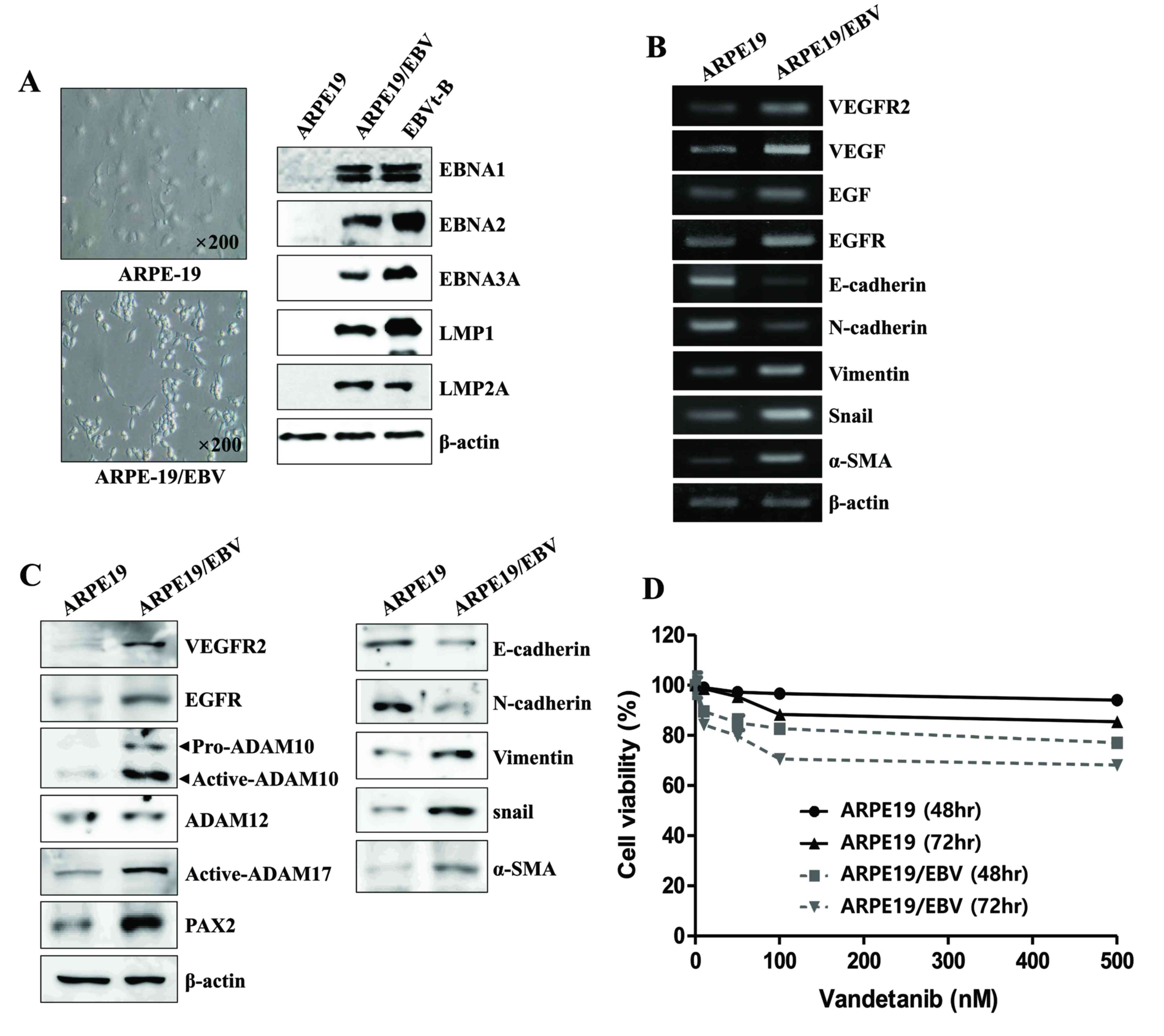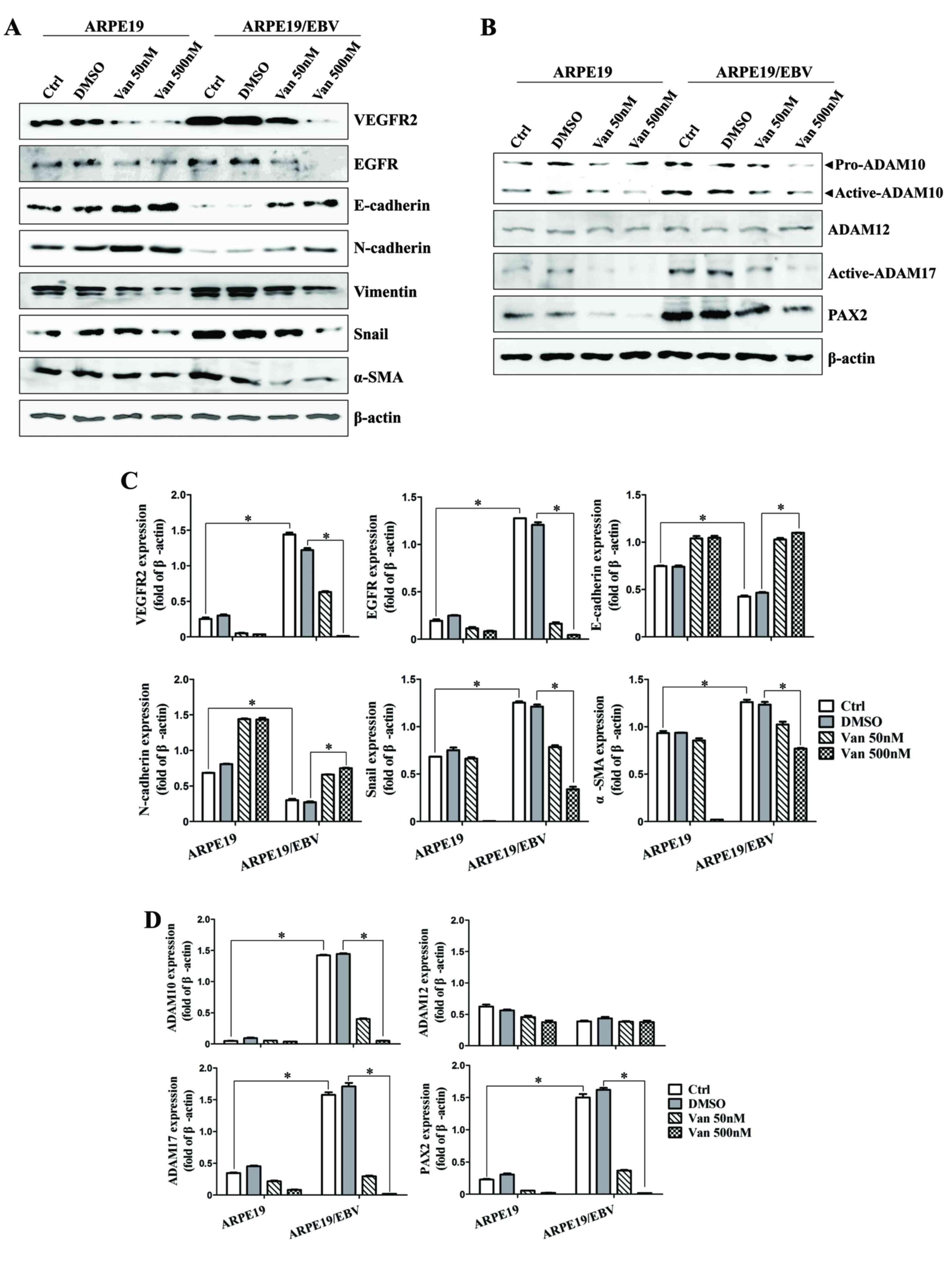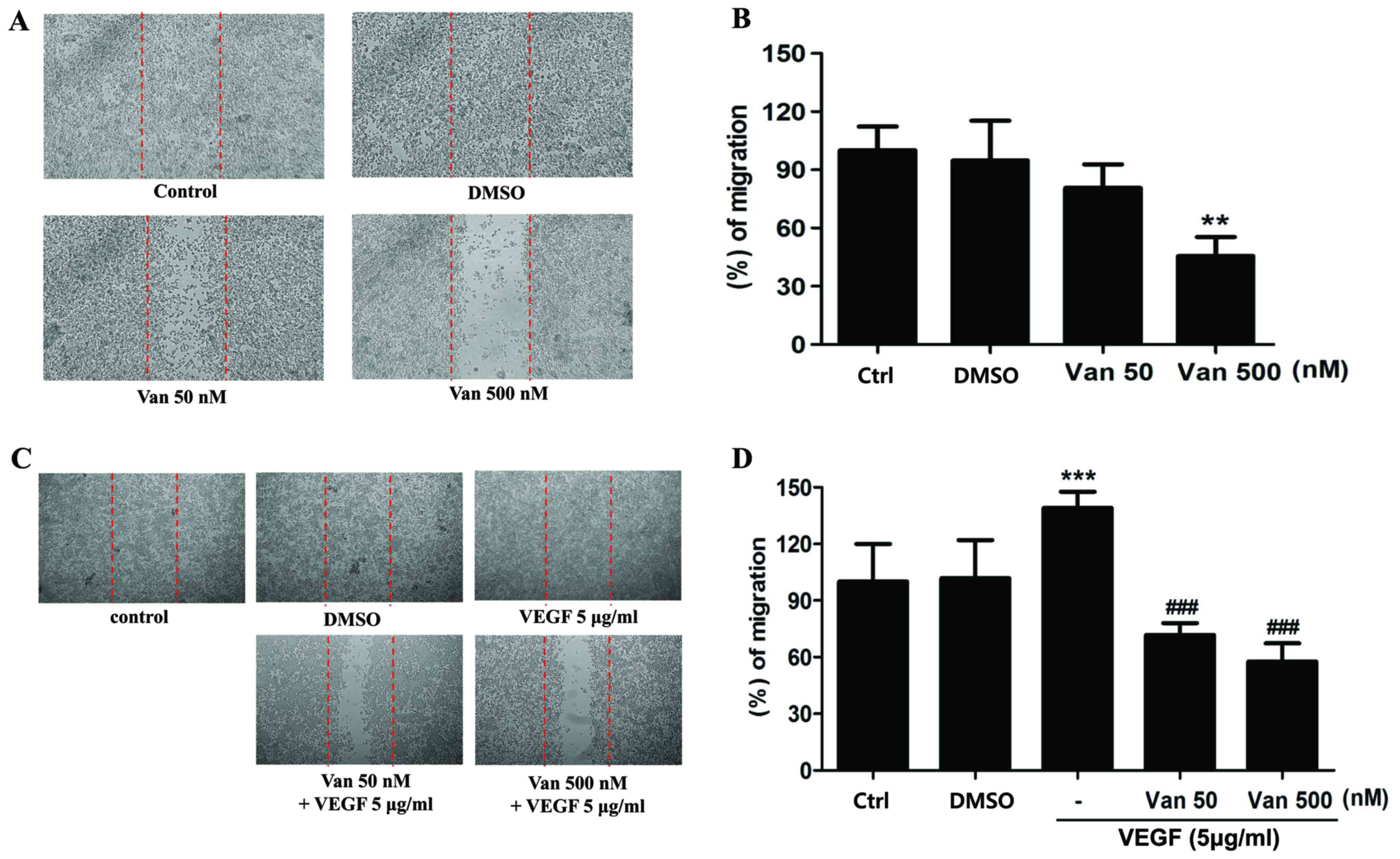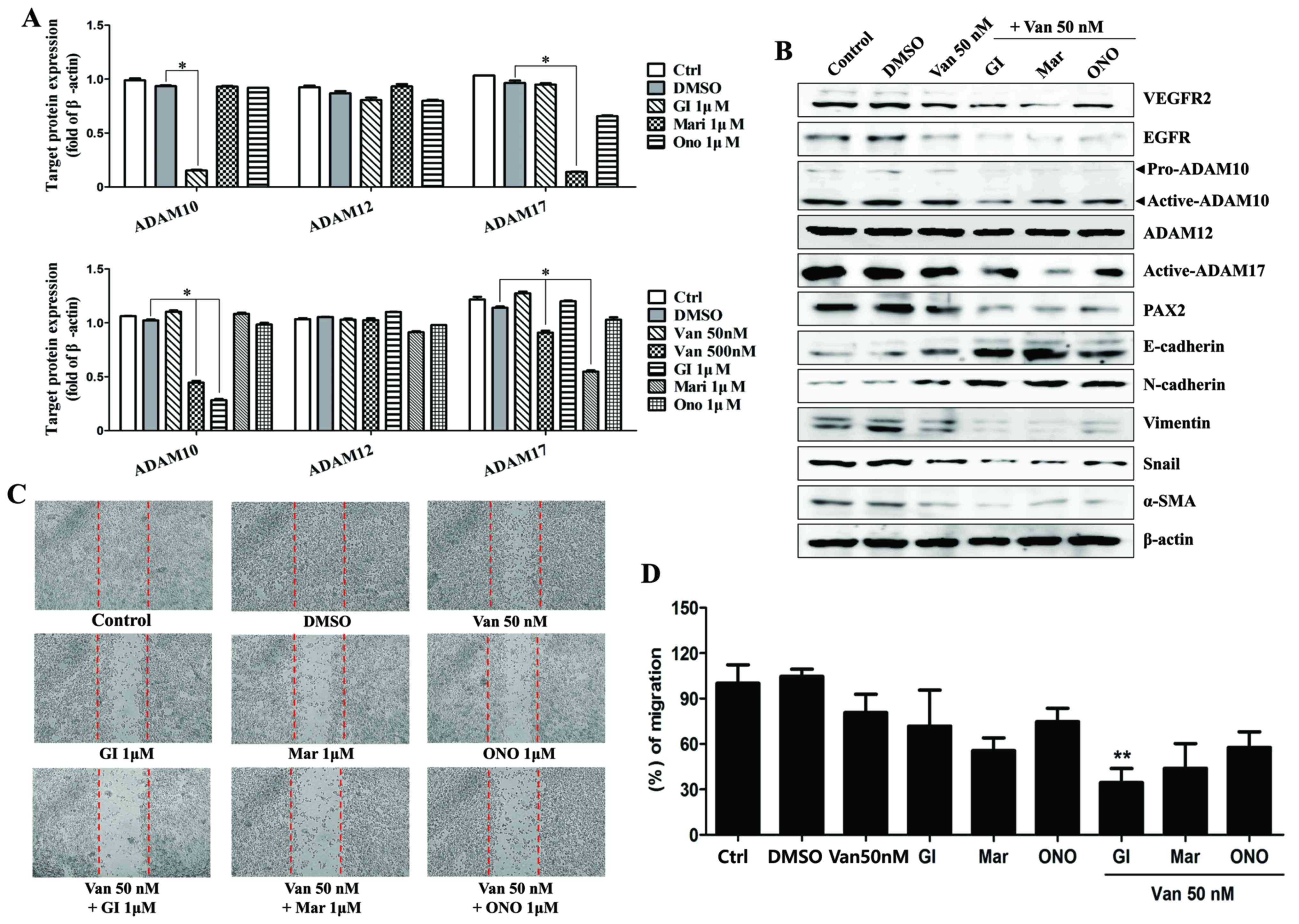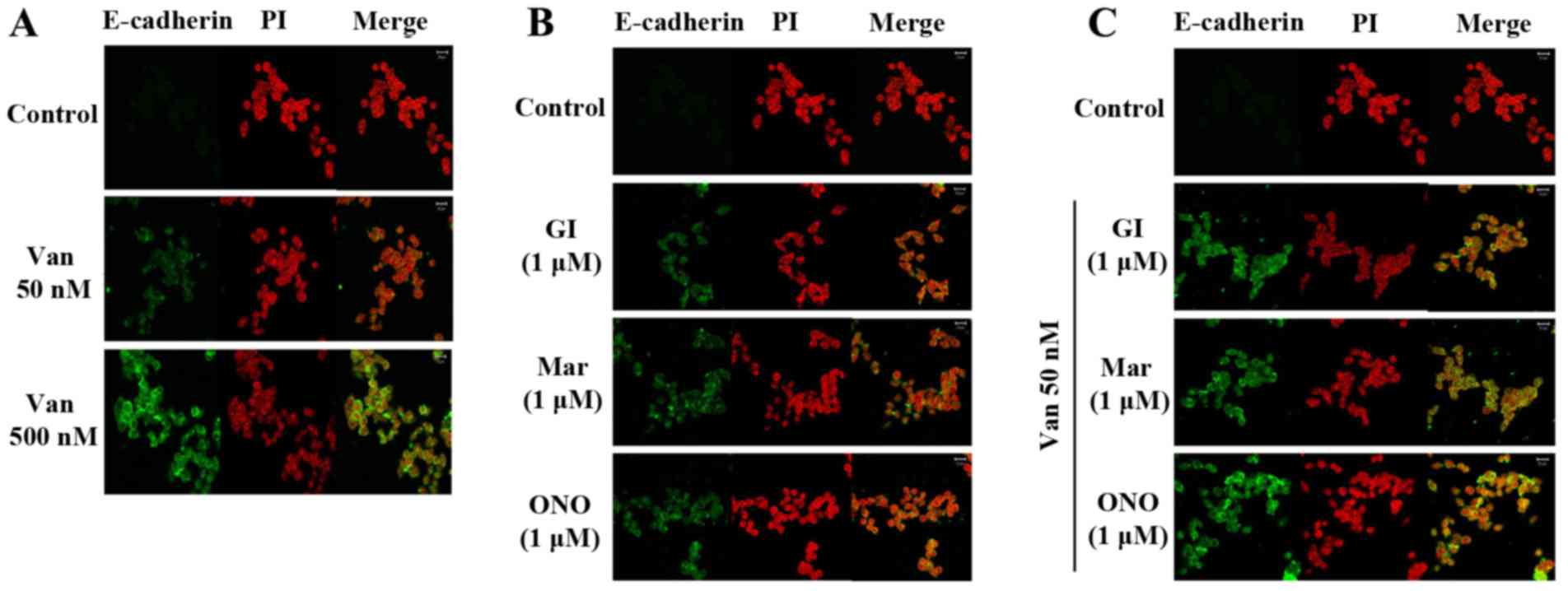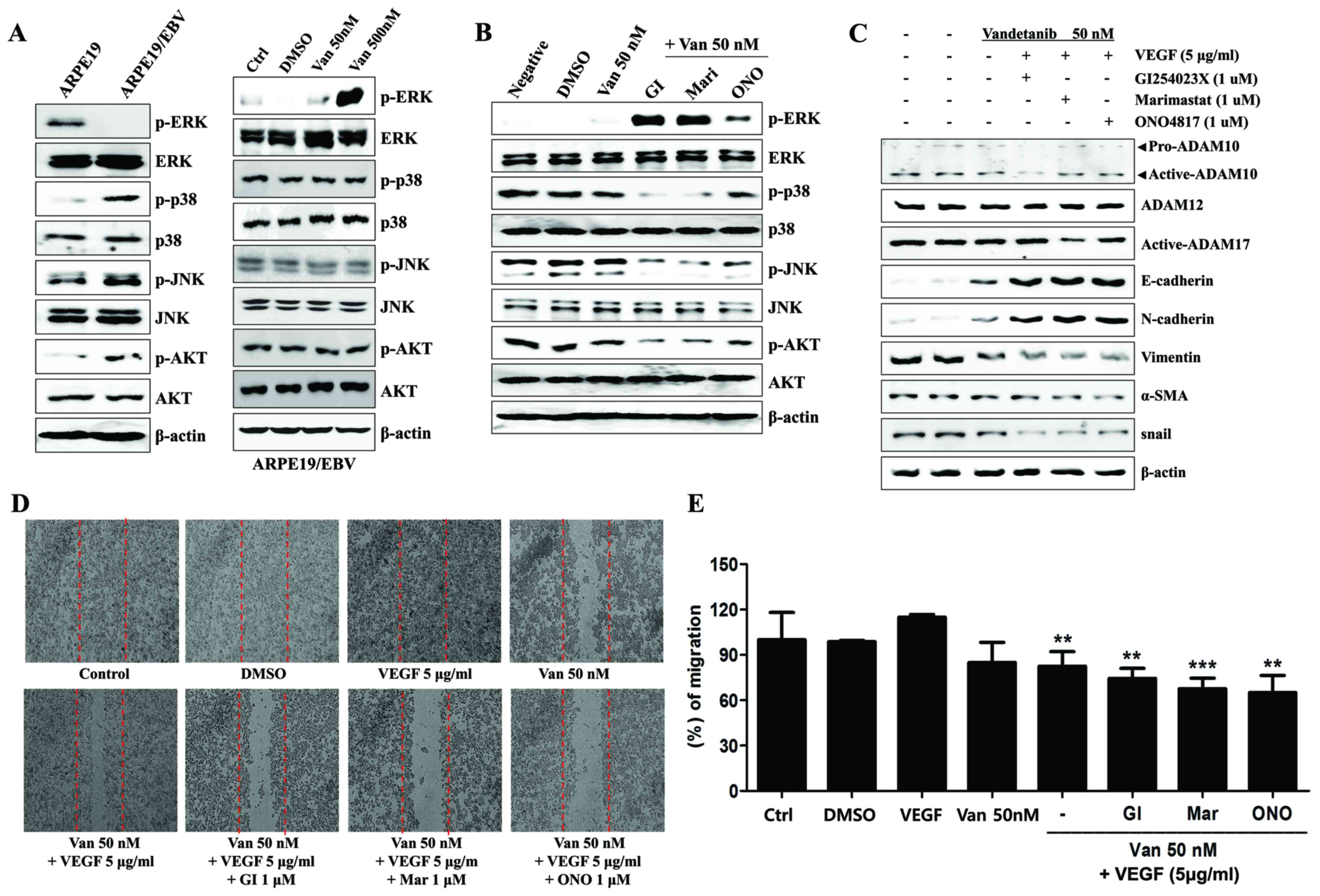|
1
|
Kerbel RS: Tumor angiogenesis: Past,
present and the near future. Carcinogenesis. 21:505–515. 2000.
View Article : Google Scholar : PubMed/NCBI
|
|
2
|
Kliffen M, Sharma HS, Mooy CM, Kerkvliet S
and de Jong PT: Increased expression of angiogenic growth factors
in age-related maculopathy. Br J Ophthalmol. 81:154–162. 1997.
View Article : Google Scholar : PubMed/NCBI
|
|
3
|
Ida H, Tobe T, Nambu H, Matsumura M, Uyama
M and Campochiaro PA: RPE cells modulate subretinal
neovascularization, but do not cause regression in mice with
sustained expression of VEGF. Invest Ophthalmol Vis Sci.
44:5430–5437. 2003. View Article : Google Scholar : PubMed/NCBI
|
|
4
|
Penn JS, Madan A, Caldwell RB, Bartoli M,
Caldwell RW and Hartnett ME: Vascular endothelial growth factor in
eye disease. Prog Retin Eye Res. 27:331–371. 2008. View Article : Google Scholar : PubMed/NCBI
|
|
5
|
Ferrara N, Houck K, Jakeman L and Leung
DW: Molecular and biological properties of the vascular endothelial
growth factor family of proteins. Endocr Rev. 13:18–32. 1992.
View Article : Google Scholar : PubMed/NCBI
|
|
6
|
Tuccillo C, Romano M, Troiani T,
Martinelli E, Morgillo F, De Vita F, Bianco R, Fontanini G, Bianco
RA, Tortora G and Ciardiello F: Antitumor activity of ZD6474, a
vascular endothelial growth factor-2 and epidermal growth factor
receptor small molecule tyrosine kinase inhibitor, in combination
with SC-236, a cyclooxygenase-2 inhibitor. Clin Cancer Res.
11:1268–1276. 2005.PubMed/NCBI
|
|
7
|
Ambati J and Fowler BJ: Mechanisms of
age-related macular degeneration. Neuron. 75:26–39. 2012.
View Article : Google Scholar : PubMed/NCBI
|
|
8
|
Swaroop A, Chew EY, Rickman CB and
Abecasis GR: Unraveling a multifactorial late-onset disease: From
genetic susceptibility to disease mechanisms for age-related
macular degeneration. Annu Rev Genomics Human Genet. 10:19–43.
2009. View Article : Google Scholar
|
|
9
|
Campochiaro PA: Ocular neovascularization.
J Mol Med (Berl). 91:311–321. 2013. View Article : Google Scholar : PubMed/NCBI
|
|
10
|
Zarbin MA: Current concepts in the
pathogenesis of age-related macular degeneration. Arch Ophthalmol.
122:598–614. 2004. View Article : Google Scholar : PubMed/NCBI
|
|
11
|
Aiello LP, Avery RL, Arrigg PG, Keyt BA,
Jampel HD, Shah ST, Pasquale LR, Thieme H, Iwamoto MA, Park JE, et
al: Vascular endothelial growth factor in ocular fluid of patients
with diabetic retinopathy and other retinal disorders. New Engl J
Med. 331:1480–1487. 1994. View Article : Google Scholar : PubMed/NCBI
|
|
12
|
Young RW: Pathophysiology of age-related
macular degeneration. Sur Ophthalmol. 31:291–306. 1987. View Article : Google Scholar
|
|
13
|
Nagineni CN, Kommineni VK, William A,
Detrick B and Hooks JJ: Regulation of VEGF expression in human
retinal cells by cytokines: Implications for the role of
inflammation in age-related macular degeneration. J Cell Physiol.
227:116–126. 2012. View Article : Google Scholar : PubMed/NCBI
|
|
14
|
Bao B, Ali S, Ahmad A, Azmi AS, Li Y,
Banerjee S, Kong D, Sethi S, Aboukameel A, Padhye SB and Sarkar FH:
Hypoxia-induced aggressiveness of pancreatic cancer cells is due to
increased expression of VEGF, IL-6 and miR-21, which can be
attenuated by CDF treatment. PLoS One. 7:e501652012. View Article : Google Scholar : PubMed/NCBI
|
|
15
|
Hirasawa M, Noda K, Noda S, Suzuki M,
Ozawa Y, Shinoda K, Inoue M, Ogawa Y, Tsubota K and Ishida S:
Transcriptional factors associated with pithelial-mesenchymal
transition in choroidal neovascularization. Mol Vis. 17:1222–1230.
2011.PubMed/NCBI
|
|
16
|
Noël A, Jost M, Lambert V, Lecomte J and
Rakic JM: Anti-angiogenic therapy of exudative age-related macular
degeneration: Current progress and emerging concepts. Trend Mol
Med. 13:345–352. 2007. View Article : Google Scholar
|
|
17
|
Zhang SX and Ma JX: Ocular
neovascularization: Implication of endogenous angiogenic inhibitors
and potential therapy. Prog Ret Eye Res. 26:1–37. 2007. View Article : Google Scholar
|
|
18
|
Wedge SR, Ogilvie DJ, Dukes M, Kendrew J,
Chester R, Jackson JA, Boffey SJ, Valentine PJ, Curwen JO, Musgrove
HL, et al: ZD6474 inhibits vascular endothelial growth factor
signaling, angiogenesis, and tumor growth following oral
administration. Cancer Res. 62:4645–4655. 2002.PubMed/NCBI
|
|
19
|
Heymach JV, Johnson BE, Prager D, Csada E,
Roubec J, Pesek M, Spásová I, Belani CP, Bodrogi I, Gadgeel S, et
al: Randomized, placebo-controlled phase II study of vandetanib
plus docetaxel in previously treated non-small cell lung cancer. J
Clin Oncol. 25:4270–4277. 2007. View Article : Google Scholar : PubMed/NCBI
|
|
20
|
Heymach JV, Paz-Ares L, De Braud F,
Sebastian M, Stewart DJ, Eberhardt WE, Ranade AA, Cohen G, Trigo
JM, Sandler AB, et al: Randomized phase II study of vandetanib
alone or with paclitaxel and carboplatin as first-line treatment
for advanced non-small-cell lung cancer. J Clin Oncol.
26:5407–5415. 2008. View Article : Google Scholar : PubMed/NCBI
|
|
21
|
Sarkar S, Mazumdar A, Dash R, Sarkar D,
Fisher PB and Mandal M: ZD6474, a dual tyrosine kinase inhibitor of
EGFR and VEGFR-2, inhibits MAPK/ERK and AKT/PI3-K and induces
apoptosis in breast cancer cells. Cancer Biol Ther. 9:592–603.
2010. View Article : Google Scholar : PubMed/NCBI
|
|
22
|
Klettner A and Roider J: Constitutive and
oxidative-stress-induced expression of VEGF in the RPE are
differently regulated by different Mitogen-activated protein
kinases. Graefes Arch Clin Exp Ophthalmol. 247:1487–1492. 2009.
View Article : Google Scholar : PubMed/NCBI
|
|
23
|
Yan X, Lin J, Rolfs A and Luo J:
Differential expression of the ADAMs in developing chicken retina.
Dev Growth Differ. 53:726–739. 2011. View Article : Google Scholar : PubMed/NCBI
|
|
24
|
Sel S, Kalinski T, Enssen I, Kaiser M,
Nass N, Trau S, Wollensak G, Bräuer L, Jäger K and Paulsen F:
Expression analysis of ADAM17 during mouse eye development. Ann
Anat. 194:334–338. 2012. View Article : Google Scholar : PubMed/NCBI
|
|
25
|
Saftig P and Reiss K: The ‘A Disintegrin
and Metalloproteases’ ADAM10 and ADAM17: Novel drug targets with
therapeutic potential? Eur J Cell Biol. 90:527–535. 2011.
View Article : Google Scholar : PubMed/NCBI
|
|
26
|
Swendeman S, Mendelson K, Weskamp G,
Horiuchi K, Deutsch U, Scherle P, Hooper A, Rafii S and Blobel CP:
VEGF-A stimulates ADAM17-dependent shedding of VEGFR2 and crosstalk
between VEGFR2 and ERK signaling. Circ Res. 103:916–918. 2008.
View Article : Google Scholar : PubMed/NCBI
|
|
27
|
Park GB, Kim D, Kim YS, Kim S, Lee HK,
Yang JW and Hur DY: The Epstein-Barr virus causes
epithelial-mesenchymal transition in human corneal epithelial cells
via Syk/src and Akt/Erk signaling pathways. Invest Ophthalmol Vis
Sci. 55:1770–1779. 2014. View Article : Google Scholar : PubMed/NCBI
|
|
28
|
Li H, Li M, Xu D, Zhao C, Liu G and Wang
F: Overexpression of Snail in retinal pigment epithelial triggered
epithelial-mesenchymal transition. Biochem Biophys Res Commun.
446:347–351. 2014. View Article : Google Scholar : PubMed/NCBI
|
|
29
|
Saika S, Kono-Saika S, Tanaka T, Yamanaka
O, Ohnishi Y, Sato M, Muragaki Y, Ooshima A, Yoo J, Flanders KC and
Roberts AB: Smad3 is required for dedifferentiation of retinal
pigment epithelium following retinal detachment in mice. Lab
Invest. 84:1245–1258. 2004. View Article : Google Scholar : PubMed/NCBI
|
|
30
|
Adamis AP, Miller JW, Bernal MT, D'Amico
DJ, Folkman J, Yeo TK and Yeo KT: Increased vascular endothelial
growth factor levels in the vitreous of eyes with proliferative
diabetic retinopathy. Am J Ophthalmol. 118:445–450. 1994.
View Article : Google Scholar : PubMed/NCBI
|
|
31
|
Chen CL, Liang CM, Chen YH, Tai MC, Lu DW
and Chen JT: Bevacizumab modulates epithelial-to-mesenchymal
transition in the retinal pigment epithelial cells via connective
tissue growth factor up-regulation. Acta Ophthalmol. 90:e389–e398.
2012. View Article : Google Scholar : PubMed/NCBI
|
|
32
|
Kon CH, Occleston NL, Aylward GW and Khaw
PT: Expression of vitreous cytokines in proliferative
vitreoretinopathy: A prospective study. Invest Ophthalmol Vis Sci.
40:705–712. 1999.PubMed/NCBI
|
|
33
|
Leask A and Abraham DJ: The role of
connective tissue growth factor, a multifunctional matricellular
protein, in fibroblast biology. Biochem Cell Biol. 81:355–363.
2003. View
Article : Google Scholar : PubMed/NCBI
|
|
34
|
Parapuram SK, Chang B, Li L, Hartung RA,
Chalam KV, Nair-Menon JU, Hunt DM and Hunt RC: Differential effects
of TGFbeta and vitreous on the transformation of retinal pigment
epithelial cells. Invest Ophthalmol Vis Sci. 50:5965–5974. 2009.
View Article : Google Scholar : PubMed/NCBI
|
|
35
|
Tanaka E, Chaikitmongkol V, Bressler SB
and Bressler NM: Vision-threatening lesions developing with
longer-term follow-up after treatment of neovascular age-related
macular degeneration. Ophthalmology. 122:153–161. 2015. View Article : Google Scholar : PubMed/NCBI
|
|
36
|
Kurihara T, Westenskow PD, Bravo S,
Aguilar E and Friedlander M: Targeted deletion of Vegfa in adult
mice induces vision loss. J Clin Invest. 122:4213–4217. 2012.
View Article : Google Scholar : PubMed/NCBI
|
|
37
|
Yoshizaki T, Sato H, Furukawa M and Pagano
JS: The expression of matrix metalloproteinase 9 is enhanced by
Epstein-Barr virus latent membrane protein 1. Proc Natl Acad Sci
USA. 95:3621–3626. 1998. View Article : Google Scholar : PubMed/NCBI
|
|
38
|
Kondo S, Wakisaka N, Schell MJ, Horikawa
T, Sheen TS, Sato H, Furukawa M, Pagano JS and Yoshizaki T:
Epstein-Barr virus latent membrane protein 1 induces the matrix
metalloproteinase-1 promoter via an Ets binding site formed by a
single nucleotide polymorphism: Enhanced susceptibility to
nasopharyngeal carcinoma. Int J Cancer. 115:368–376. 2005.
View Article : Google Scholar : PubMed/NCBI
|
|
39
|
Murono S, Inoue H, Tanabe T, Joab I,
Yoshizaki T, Furukawa M and Pagano JS: Induction of
cyclooxygenase-2 by Epstein-Barr virus latent membrane protein 1 is
involved in vascular endothelial growth factor production in
nasopharyngeal carcinoma cells. Proc Natl Acad Sci USA.
98:6905–6910. 2001. View Article : Google Scholar : PubMed/NCBI
|
|
40
|
Lin JC, Liao SK, Lee EH, Hung MS, Sayion
Y, Chen HC, Kang CC, Huang LS and Cherng JM: Molecular events
associated with epithelial to mesenchymal transition of
nasopharyngeal carcinoma cells in the absence of Epstein-Barr virus
genome. J Biomed Sci. 16:1052009. View Article : Google Scholar : PubMed/NCBI
|
|
41
|
Li Y, Yang X, Su LJ and Flaig TW: VEGFR
and EGFR inhibition increases epithelial cellular characteristics
and chemotherapy sensitivity in mesenchymal bladder cancer cells.
Oncol Rep. 24:1019–1928. 2010.PubMed/NCBI
|
|
42
|
Yoshikawa D, Ojima H, Kokubu A, Ochiya T,
Kasai S, Hirohashi S and Shibata T: Vandetanib (ZD6474), an
inhibitor of VEGFR and EGFR signalling, as a novel
molecular-targeted therapy against cholangiocarcinoma. Br J Cancer.
100:1257–1266. 2009. View Article : Google Scholar : PubMed/NCBI
|
|
43
|
Chau NG and Haddad RI: Vandetanib for the
treatment of medullary thyroid cancer. Clin Cancer Res. 19:524–529.
2013. View Article : Google Scholar : PubMed/NCBI
|
|
44
|
Matsuzaki H, Tamatani M, Yamaguchi A,
Namikawa K, Kiyama H, Vitek MP, Mitsuda N and Tohyama M: Vascular
endothelial growth factor rescues hippocampal neurons from
glutamate-induced toxicity: Signal transduction cascades. FASEB J.
15:1218–1220. 2001.PubMed/NCBI
|
|
45
|
Roberts DM, Kearney JB, Johnson JH,
Rosenberg MP, Kumar R and Bautch VL: The vascular endothelial
growth factor (VEGF) receptor Flt-1 (VEGFR-1) modulates Flk-1
(VEGFR-2) signaling during blood vessel formation. Am J Pathol.
164:1531–1535. 2004. View Article : Google Scholar : PubMed/NCBI
|
|
46
|
Inoue K, Torimura T, Nakamura T, Iwamoto
H, Masuda H, Abe M, Hashimoto O, Koga H, Ueno T, Yano H and Sata M:
Vandetanib, an inhibitor of VEGF receptor-2 and EGF receptor,
suppresses tumor development and improves prognosis of liver cancer
in mice. Clin Cancer Res. 18:3924–3933. 2012. View Article : Google Scholar : PubMed/NCBI
|
|
47
|
Giannelli G, Azzariti A, Sgarra C,
Porcelli L, Antonaci S and Paradiso A: ZD6474 inhibits
proliferation and invasion of human hepatocellular carcinoma cells.
Biochem Pharmacol. 71:479–485. 2006. View Article : Google Scholar : PubMed/NCBI
|
|
48
|
Paudel S, Kim YH, Huh MI, Kim SJ, Chang Y,
Park YJ, Lee KW and Jung JC: ADAM10 mediates N-cadherin ectodomain
shedding during retinal ganglion cell differentiation in primary
cultured retinal cells from the developing chick retina. J Cell
Biochem. 114:942–954. 2013. View Article : Google Scholar : PubMed/NCBI
|
|
49
|
Peschon JJ, Slack JL, Reddy P, Stocking
KL, Sunnarborg SW, Lee DC, Russell WE, Castner BJ, Johnson RS,
Fitzner JN, et al: An essential role for ectodomain shedding in
mammalian development. Science. 282:1281–1284. 1998. View Article : Google Scholar : PubMed/NCBI
|
|
50
|
Caolo V, Swennen G, Chalaris A, Wagenaar
A, Verbruggen S, Rose-John S, Molin DG, Vooijs M and Post MJ:
ADAM10 and ADAM17 have opposite roles during sprouting
angiogenesis. Angiogenesis. 18:13–22. 2015. View Article : Google Scholar : PubMed/NCBI
|
|
51
|
Majka S, McGuire PG and Das A: Regulation
of matrix metalloproteinase expression by tumor necrosis factor in
a murine model of retinal neovascularization. Invest Ophthalmol Vis
Sci. 43:260–266. 2002.PubMed/NCBI
|
|
52
|
Lucitti JL, Mackey JK, Morrison JC, Haigh
JJ, Adams RH and Faber JE: Formation of the collateral circulation
is regulated by vascular endothelial growth factor-A and a
disintegrin and metalloprotease family members 10 and 17. Circ Res.
111:1539–1550. 2012. View Article : Google Scholar : PubMed/NCBI
|















